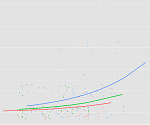One of the things I love about MIXED in SPSS is that the syntax is very similar to GLM. So anyone who is used to the GLM syntax has just a short jump to learn writing MIXED.
Which is a good thing, because many of the concepts are a big jump.
And because the MIXED dialogue menus are seriously unintuitive, I’ve concluded you’re much better off using syntax.
I was very happy a few years ago when, with version 19, SPSS finally introduced generalized linear mixed models so SPSS users could finally run logistic regression or count models on clustered data.
But then I tried it, and the menus are even less intuitive than in MIXED.
And the syntax isn’t much better. In this case, the syntax structure is quite different than for MIXED. (more…)
Linear, Logistic, Tobit, Cox, Poisson, Zero Inflated… The list of regression models goes on and on before you even get to things like ANCOVA or Linear Mixed Models.
In this webinar, we will explore types of regression models, how they differ, how they’re the same, and most importantly, when to use each one.
Note: This training is an exclusive benefit to members of the Statistically Speaking Membership Program and part of the Stat’s Amore Trainings Series. Each Stat’s Amore Training is approximately 90 minutes long.
About the Instructor

Karen Grace-Martin helps statistics practitioners gain an intuitive understanding of how statistics is applied to real data in research studies.
She has guided and trained researchers through their statistical analysis for over 15 years as a statistical consultant at Cornell University and through The Analysis Factor. She has master’s degrees in both applied statistics and social psychology and is an expert in SPSS and SAS.
Not a Member Yet?
It’s never too early to set yourself up for successful analysis with support and training from expert statisticians.
Just head over and sign up for Statistically Speaking.
You'll get access to this training webinar, 130+ other stats trainings, a pathway to work through the trainings that you need — plus the expert guidance you need to build statistical skill with live Q&A sessions and an ask-a-mentor forum.
Like some of the other terms in our list–level and beta–GLM has two different meanings.
It’s a little different than the others, though, because it’s an abbreviation for two different terms:
General Linear Model and Generalized Linear Model.
It’s extra confusing because their names are so similar on top of having the same abbreviation.
And, oh yeah, Generalized Linear Models are an extension of General Linear Models.
And neither should be confused with Generalized Linear Mixed Models, abbreviated GLMM.
Naturally. (more…)
Last month I did a webinar on Poisson and negative binomial models for count data. With a few hundred participants, we ran out of time to get through all the questions, so I’m answering some of them here on the blog.
This set of questions are all related to when it’s appropriate to treat count data as continuous and run the more familiar and simpler linear model.
Q: Do you have any guidelines or rules of thumb as far as how many discrete values an outcome variable can take on before it makes more sense to just treat it as continuous?
The issue usually isn’t a matter of how many values there are. (more…)
Need to dummy code in a Cox regression model?
Interpret interactions in a logistic regression?
Add a quadratic term to a multilevel model?
 This is where statistical analysis starts to feel really hard. You’re combining two difficult issues into one.
This is where statistical analysis starts to feel really hard. You’re combining two difficult issues into one.
You’re dealing with both a complicated modeling technique at Stage 3 (survival analysis, logistic regression, multilevel modeling) and tricky effects in the model (dummy coding, interactions, and quadratic terms).
The only way to figure it all out in a situation like that is to break it down into parts. (more…)
1. For a general overview of modeling count variables, you can get free access to the video recording of one of my The Craft of Statistical Analysis Webinars:
Poisson and Negative Binomial for Count Outcomes
2. One of my favorite books on Categorical Data Analysis is:
Long, J. Scott. (1997). Regression models for Categorical and Limited Dependent Variables. Sage Publications.
It’s moderately technical, but written with social science researchers in mind. It’s so well written, it’s worth it. It has a section specifically about Zero Inflated Poisson and Zero Inflated Negative Binomial regression models.
3. Slightly less technical, but most useful only if you use Stata is >Regression Models for Categorical Dependent Variables Using Stata, by J. Scott Long and Jeremy Freese.
4. UCLA’s ATS Statistical Software Consulting Group has some nice examples of Zero-Inflated Poisson and other models in various software packages.



 This is where statistical analysis starts to feel really hard. You’re combining two difficult issues into one.
This is where statistical analysis starts to feel really hard. You’re combining two difficult issues into one.